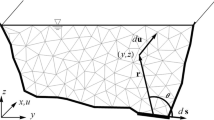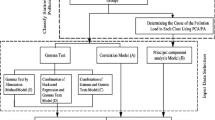Abstract
This paper employs a new estimation method for estimating stage–discharge rating curve parameters. In typical practical applications, the original non-linear rating curve is transformed into a simple linear regression model by log-transforming the measurement without examining the effect of heteroscedasticity of residuals. Therefore, the model with pseudo-likelihood estimation is developed in this study to deal with heteroscedasticity of residuals in the original non-linear model. The parameters of rating curves and variance functions of errors are simultaneously estimated by the pseudo-likelihood estimation (P-LE) method. Also simulated annealing, a sort of global optimization techniques, is adapted to minimize the log likelihood of the weighted residuals. At first, the developed P-LE model was applied to a hypothetical site where stage–discharge data were generated by incorporating various errors for statistical test. Also, the limit of stages for segmentation is estimated in the process of P-LE using the Heaviside function. For the validation of effects of the developed P-LE model, the results of the conventional log-transformed linear regression (LT-LR) model and the P-LE model are estimated and compared. After statistical simulation, the developed P-LE model is then applied to the real data sets from six gauge stations in the Geum River basin. It can be suggested that this new estimation method is applied to real river sites to successfully determine the weights taking into account error distributions from observed discharge data.
Similar content being viewed by others
References
Akaike H (1974) A new look at the statistical model identification. IEEE Trans Autom Control AC-19:716–723
Box GEP, Cox DR (1964) An analysis of transformations. J R Statist Soc Ser B, 26:211–243
Carroll RJ, Ruppert D (1988) Transformation and weighting in regression. Chapman & Hall, USA
Clarke RT (1999) Uncertainty in the estimation of mean annual flood due to rating-curve indefinition. J Hydrol 222:185–190
DeGagne MPJ, Douglas GG, Hudson HR, Simonovic SP (1996) A decision support system for the analysis and use of stage–discharge rating curves. J Hydrol 184:225–241
Feder PI (1975) The log-likelihood rating in segmented regression. Ann Statist 3:84–97
Goldfield SM, Quandt RE (1992) Non-linear least squares: the variable projection method and its applications. Inver Probl 1–26
Herschy RW (1995) Streamflow measurement, 2nd edn. Chapman & Hall, England
Hinkley DV (1969) Inference about the intersection in two-phase regression. Biometrika 56:495–504
Huet S, Bouvier A, Gruet MA, Jolivet E (1996) Statistical tools for nonlinear regression. Springer, London
ISO (1998) Measurement of liquid flow in open channels—part 2: determination of the stage–discharge relationship. ISO standard 1100-2. International organization of standards, pp 133–153
Kirkpatrick S, Gellat CD, Vecchi MP (1983) Optimization by simulated annealing. Science 220:671–680
Korea Institute of Construction Technology (1994) Stage and discharge relation curve. Water resources management technique research report, Seoul (in Korean)
Lambie JC (1978) Measurement of flow-velocity-area methods. In: Hershcy RW (ed) Hydrometry: principles and practices, chapter 1. Wiley, Chichester
Lee KS (2001) The establishment of water resources information analysis system. Water resources investigation research report, Korea water resources corporation, Daejeon (in Korean)
Metropolis N, Rosenbluth AW, Teller AW, Teller E (1953) Equation of state calculation by fast computing machines. J Chem Phys 21:1087–1091
Montgomery DC, Peck EA (1992) Introduction to linear regression analysis, 2nd edn. Wiley, USA
Mosley MP, McKerchar AI (1993) Streamflow. In: Maidment DR (ed) Handbook of hydrology. McGraw-Hill, New York, pp 8.1–8.39
Overlier P (2006) Modelling stage–discharge relationships affected by hysteresis using the Jones formula and nonlinear regression. Hydrological Sciences 51(3):365–388
Petersen-Øverleir A (2004) Accounting for heteroscedasticity in rating curve estimates. J Hydrol 292:173–181
Petersen-Øverleir A, Reitan T (2005) Objective segmentation in compound rating curves. J Hydrol 311:188–201
Philips RF (1991) A constrained maximum-likelihood approach to estimating switching regression. J Econometr 48:241–262
Quandt RE (1972) A new approach to estimating switching regressions. J Am Statist Assoc 67:306–310
Rantz SE (1982) Measurement and computation of streamflow, vol II. Computation of discharge. US geological survey water supply paper 2175, Washington
Rayward-Smith VJ, Osman IH, Reeves CR, Smith GD (1996) Modern heuristic search methods. Wiley, England
Reitan T, Petersen-Øverleir A (2006) Existence of the frequentistic regression estimate of a power-law with location parameter, with applications for making discharge rating curves. Stoc Env Res Risk Asses 20:445–453
Sauer VB, Meyer RW (1992) Determination of error in individual discharge measurements. US Geological Survey Open-file Report: 92–144
Schmidt AR, Yen BC (2002) Stage–discharge ratings revisited. Hydraulic measurements and experimental methods. In: Proc, EWRI and IAHR joint conf, Colo
Schwartz G (1979) Estimating the dimension of a model. Ann Statist 6:461–464
Seber GAF, Wild CJ (1989) Nonlinear regression. Wiley, USA
Sivapragasam C, Mutill N (2005) Discharge rating curve extension—a new approach. Water Resour Manag 19:505–520
Tishler A, Zang I (1981) A new maximum-likelihood algorithm for piecewise regression. J Am Statist Assoc 76:980–987
Torsten D, Gerd M, Torsten S (2002) Extrapolating stage–discharge relationships by numerical modeling. In: Int conf on hydraulic engineering. Warshaw
Venetis C (1970) A note on the estimation of the parameters in logarithmic stage–discharge relationships with estimation of their error. Bull. IASH 15:105–111
World Meteorological Organization (1994) Guide to hydrological practices, 5th edn. WMO-No.168, Geneva
Author information
Authors and Affiliations
Corresponding author
Rights and permissions
About this article
Cite this article
Lee, W.S., Lee, K.S., Kim, S.U. et al. The Development of Rating Curve Considering Variance Function Using Pseudo-likelihood Estimation Method. Water Resour Manage 24, 321–348 (2010). https://doi.org/10.1007/s11269-009-9448-8
Received:
Accepted:
Published:
Issue Date:
DOI: https://doi.org/10.1007/s11269-009-9448-8




